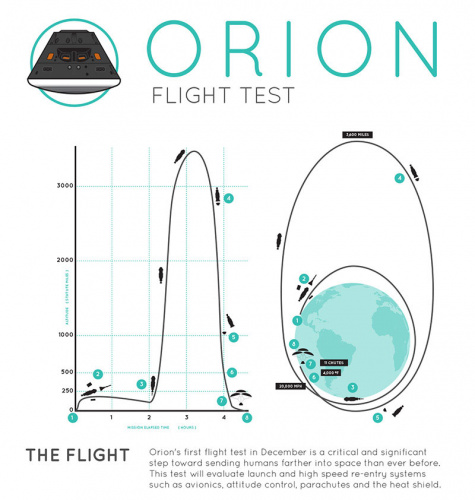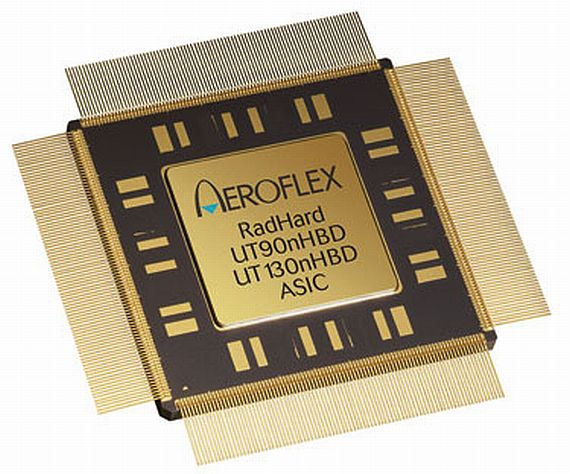As the new Orion capsule takes flight, NASA is working to better understand what we did almost 40 years ago with the moon landings. Why have we not ventured beyond the Van Allen belt since then? Hopefully when you read this Orion will already be bobbing around in the Pacific Ocean.
UPDATE 12/5/14 10:16am MT - Orion Flight was a success! Retrieval crews are working to bring Orion onboard the recovery vessel.
Projected Flight Plan of Orion (Source: NASA)
NASA is testing a new capsule and re-entry design to eventually take astronauts into deep space and land them on Mars. But first, they have to get through the Van Allen belt.
The Van Allen Radiation belt is a protective layer of charged particles surrounding the Earth. This layer of radiation is trapped by the magnetic field produced by the Earth's molten core. This radiation belt gives earth a buffer to the cosmic radiation experienced in deep space. This radiation can harm astronauts and any electronics onboard.
Van Allen Belt Diagram (Source: Wikipedia)
Most mission critical systems in human spacecraft utilize what are knows as "Rad-Hard" components. Typically these components are logic components or microprocessors. The device is either shielded from the effects from radiation or the device has a way to "detect" an anomaly and correct it. One solution for checking errors is to simply have multiple redundant IC's and they use [voting logic](http://en.wikipedia.org/wiki/Redundancy_(engineering)#Voting_logic ) to determine if a command executed correctly. Another solution is to have two entire flight controllers that can back each other up.
The International Space Station is lucky because it is well within the protection of the Van Allen belt. This allows for the use of Commercial Off The Self (COTS) parts inside the space station. So most non-critical hardware is developed with parts you would use on earth. The same goes for microsatellites. We have heard from customers that even Sparkfun components have flown in space with no adverse behavior. While the Orion capsule is designed to protect hardware from radiation, the question remains on how well it performs.
Rad-Hard IC packaging (Source: Militaryaerospace.com)
Purchasing Rad-hard processors isn't something Digikey frequently carries. It also takes quite a bit of testing and verification to prove that the shielding works. Then there is the term "flight heritage", or how many times it has flown in space. All of these factors can take a processor that would normally cost $10 and inflate it to over $10,000.
We have been lucky in Low Earth Orbit (LEO), but after this test flight the training wheels are off. I am excited to see what data comes from this launch and what new constraints engineers will have to work with. In short, today's test flight will bring more data to help engineers design systems that will be safe and reliable to send astronauts further than ever.









A very successful flight! It's a shame that the main stream media couldn't care less about a significant milestone: the first time that a manned capable craft left low Earth orbit in 42 years. But unless there is a catastrophe, riot, shooting, or a celebrity having a hissey fit, nobody cares. It's a sad state of affairs that good news or science and technology are no longer interesting.
Just watched the splash down. This is a step in the right direction for Science and Engineering! Thanks NASA for doing something worth while with our tax dollars.
It is also not just EM radiation, but thermal shock as well, in the sun (at least close in) it is REALLY hot and in the shade of a planet it is REALLY cold, which produces enormous thermal stresses on components. Per wikipedia the martian surface varies from a polar low temp of -153C to a daytime high of 35C (-243F - 95F). That's at least with some atmosphere around and the thermal mass of a planet, deep space is harsher...
Exactly, plus transitioning between those extremes causes mechanical stress. Combine this with the vibration seen in a rocket launch and you have a recipe for finding your solder joint problems REALLY fast.
The level of engineering that goes into any space hardware is amazing.
10K is a bit low for rad hard space products. A RAD750 starts around 250K.
I was looking more at individual components, yes for a completed system, this adds up quick. Then you have to add the integration testing costs.
Radiation is also the reason why no one will be landing on or orbiting Europa anytime soon. When it comes up, it's fairly common to see internet comments that complain that the Europa Clipper will only do flybys, or that the JUICE mission plans to orbit Ganymede and not Europa.
But building radiation hardened electronics and instruments that can survive the radiation environment around Europa is simply not feasible.
"Voting Logic" makes me think of the Magi computers in the Evangelion anime series. I'm trying really hard right now to formulate a project using this in my head. Three ATMEGAs implementing a voting system to accomplish tasks, but what would be the source of interference?? Something more earthly than cosmic radiation. Hmm....
Being within the Van Allen belt might allow for COTS parts, but I don't see COTS parts all that often. While radiation might not be a problem, reliability is. Especially in mission critical electronics. Traditionally Mil Spec and screened parts have been used in launch vehicles and satellites (at least the parts I've worked with). It's possible they might use some COTs in the space station just because you have a human around to fix any broken components.
You are correct; if you have mission-critical performance requirements, and the budget to afford it, you use flight-qualified hardware. But there are a lot of student missions in LEO running quite well on COTS parts, primarily because they don't have the budget for anything else. (The really smart groups do their own screening, burn-in, and other low-cost testing methodologies.) And they do use a lot of COTS hardware on the ISS (Thinkpads are everywhere) with very few radiation-related issues.
Wow, if student groups are screening and doing burn-in, I'm impressed. That's an amazing learning experience. Placing a transistor in a schematic is one thing. Knowing how it can fail, how it changes over temperature, what your margins are (and on and on), can sometimes be the real engineering. My hats off to them.
Shielding, which you mention, is a challenge because the shielding must be thick and dense to be effective. "Thick and dense" means "heavy" and which in turn means "expensive to launch". So a custom designed self monitoring part will probably be "cheaper" than simply shielding an off the shelf part. Here on earth (like in radiation therapy) we use shielding and preventive replacement and it's more cost effective. Replacement is tougher when the device is outside the Van Allen Belt as well.
Didn't we already go past the Van Allen belts when we landed on the moon? Also what about the voyagers? Been there and done that I think!
"As the new Orion capsule takes flight, NASA is working to better understand what we did almost 40 years ago with the moon landings." Yes, we have ventured that far. But we did it on Rope Core memory. We routinely send satellites beyond the belt, and the harsh environment is exactly why they are the size of moving vans. Also NASA was a bit more cavalier back then.
The size is not because of the shielding. It's because of maneuvering fuel, power supplies and equipment needed to carry out the mission. The shielded electronics are usually comparable to an old desktop in size, nowhere near a moving van. Most of an unmanned spacecraft is not radiation shielded because mechanical parts are not affected by radiation. Thermal shielding is a simple as a piece of aluminized mylar, not heavy at all. The best radiation shields are actually non-metallic. Materials that are made predominantly of protons, such as hydrocarbons and water, are actually more effective radiation absorbers than metals, especially since they do not emit secondary radiation. In fact, here on Earth, silicone rubber was used to shield silicon RAM dies from alpha particles (generated by the IC case) when cell sizes became small enough to be discharged by ambient radiation. Polyethylene and paraffin (the wax, not kerosene) are still used for high-speed neutron shields.
Almost anything can block alpha, but blocking beta, neutron, gamma and x-ray. Now that is impressive. I was wondering if something lighter than lead could be used for those. Really interesting. Thanks.
NASA is testing a new capsule and re-entry design to eventually take astronauts into deep space and land them on Mars. But fist, they have to get through the Van Allen belt
Might be a typo in there. :P
You all are too good. Fixed it. No more before coffee post writing for me.
No worries. It's kinda like open source community blogging.
The nasa and digikey links seem a bit off
https://www.sparkfun.com/news/www.nasa.gov
https://www.sparkfun.com/news/www.digikey.com
Should be fixed now. Thanks!